| Listing 1 - 10 of 21 | << page >> |
Sort by
|
Multi
ISBN: 9056821458 Year: 1998 Publisher: Heverlee Katholieke Universiteit Leuven. Faculteit der Toegepaste Wetenschappen
Abstract | Keywords | Export | Availability | Bookmark
 Loading...
Loading...Choose an application
- Reference Manager
- EndNote
- RefWorks (Direct export to RefWorks)
Academic collection --- #BIBC:T1998 --- 681.3*E4 --- Coding and information theory: data compaction and compression; formal modelsof communication; nonsecret encoding schemes--See also {681.3*H11} --- Theses --- 681.3*E4 Coding and information theory: data compaction and compression; formal modelsof communication; nonsecret encoding schemes--See also {681.3*H11}
Dissertation
ISBN: 9789460180408 Year: 2009 Publisher: Leuven Katholieke Universiteit Leuven
Abstract | Keywords | Export | Availability | Bookmark
 Loading...
Loading...Choose an application
- Reference Manager
- EndNote
- RefWorks (Direct export to RefWorks)
Deze thesis bestudeert het onderwerp 'white-box cryptografie' (WBC), dat zich op software-implementaties van cryptografische primitieven (zoals vercijferingsschema's) concentreert. Traditioneel worden cryptografische primitieven ontworpen om gegevens en sleutels te beschermen tegen 'black-box' aanvallen. Hierbij heeft de aanvaller kennis van het algoritme en kan hij de invoer naar en de uitvoer van het primitief bestuderen. Maar hij heeft geen zicht op de interne werking van een sleutel-geinstantieerd primitief tijdens de uitvoering (zwarte doos). In deze thesis beschouwen we een aanvalsmodel waarbij de aanvaller onbeperkte toegang heeft tot de software-implementatie: het white-box model. Het doel van white-box implementaties is om in een dergelijke context een bepaald niveau van bescherming te bekomen. Het belangrijkste deel van deze thesis behandelt het nagaan van de veiligheid van white-box implementaties. Deze bijdrage is tweezijdig. Allereerst worden de praktische white-box implementaties van DES en AES vercijferingsalgoritmen beschreven, en hun cryptanalyse voorgesteld. Deze resultaten worden verder uitgebreid naar generische aanvallen, wat het pad opent naar nieuwe technieken. Aangezien nog geen formele definities van white-box cryptografie voorgesteld werden en de praktische white-box implementaties zonder bewijs van veiligheid voorzien zijn, dringt zich een studie op naar het formeel definieren van white-box cryptografie. Dit is de tweede grote bijdrage. De studie van theoretische obfuscatie en bewijsbare veiligheid resulteert in een definitie van WBC, waarbij we de veiligheidsvereisten omvatten voor een bepaald cryptografisch primitief met geassocieerde veiligheidsnotie. Dit nieuw theoretisch model levert een context op, waarin de veiligheid van white-box implementaties bestudeerd kan worden, en leidt tot een aantal positieve en negatieve resultaten. Gezien de praktische mogelijkheden die kunnen voortvloeien uit WBC, beeindigen we deze thesis met een overzicht van een selectie van toepassingen en verwante onderzoeksdomeinen, aan welke dit onderzoek kan toe bijdragen. This thesis studies the topic of 'white-box cryptography' (WBC), which focuses on software implementations of cryptographic primitives (such as encryption schemes). Traditionally, cryptographic primitives are designed to protect data and keys against 'black-box' attacks. In such a context, an adversary has knowledge of the algorithm and may examine various inputs to and outputs from the system, but has no visibility on the internal details of the execution of a key instantiated primitive. In contrast, the goal of white-box implementations is to provide a degree of robustness against attacks from the execution environment. In such an environment, an adversary has unrestricted access to the software implementation. The main part of this dissertation covers the security assessment of white-box implementations. This contribution is two-fold: we study practical white-box techniques and perform a theoretical study. First, a study is conducted on the practical white-box implementations of DES and AES encryption algorithms, which includes their cryptanalysis. Subsequently, generic cryptanalysis results are described, which opens a discussion towards white-box design strategies. Since no formal definitions of white-box cryptography were presented before and the proposed white-box implementations did not come with any proof of security, we initiate a study towards a theoretical model for white-box cryptography. The study on formal models of obfuscation and provable security leads to a definition where we capture the security requirements of WBC defined over some cryptographic scheme and a security notion. This new theoretical model provides a context to investigate the security of white-box implementations, which leads to a number of positive and negative possibility results. Considering the practical interest of research in WBC, we conclude with an overview of a selection of applications and related research fields that might benefit from and contribute to this research topic. praktische mogelijkheden die kunnen voortvloeien uit WBC, beeindigen we deze thesis met een overzicht van een selectie van toepassingen en verwante onderzoeksdomeinen, aan welke dit onderzoek kan toe bijdragen. and related research fields that might benefit from and contribute to this research topic.
Academic collection --- 654 <043> --- 681.3*E4 <043> --- Telecommunication and telecontrol (organization, services)--Dissertaties --- Coding and information theory: data compaction and compression; formal modelsof communication; nonsecret encoding schemes--See also {681.3*H11}--Dissertaties --- Theses --- 681.3*E4 <043> Coding and information theory: data compaction and compression; formal modelsof communication; nonsecret encoding schemes--See also {681.3*H11}--Dissertaties
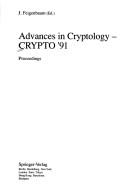
ISBN: 3540551883 0387551883 Year: 1992 Volume: vol 576 Publisher: New York, NY : Springer-Verlag,
Abstract | Keywords | Export | Availability | Bookmark
 Loading...
Loading...Choose an application
- Reference Manager
- EndNote
- RefWorks (Direct export to RefWorks)
681.3*E3 --- 681.3*E4 --- Data encryption: data encryption standard; DES; public key cryptosystems --- Coding and information theory: data compaction and compression; formal modelsof communication; nonsecret encoding schemes--See also {681.3*H11} --- 681.3*E4 Coding and information theory: data compaction and compression; formal modelsof communication; nonsecret encoding schemes--See also {681.3*H11} --- 681.3*E3 Data encryption: data encryption standard; DES; public key cryptosystems --- Computers --- Access control --- Congresses --- Cryptography --- Computers - Access control - Congresses. --- Cryptography - Congresses.
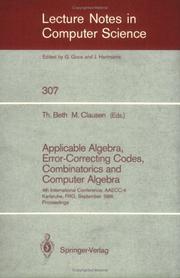
ISBN: 354019200X 038719200X 3540391339 Year: 1988 Volume: vol 307 Publisher: Berlin Springer
Abstract | Keywords | Export | Availability | Bookmark
 Loading...
Loading...Choose an application
- Reference Manager
- EndNote
- RefWorks (Direct export to RefWorks)
This volume contains the proceedings of the 4th International Conference on Applicable Algebra, Error-Correcting Codes, Combinatorics and Computer Algebra (AAECC-4), held in Karlsruhe, 23-26 September, 1986. Selected papers which were given at the conference have been reviewed a second time and are presented here.
Artificial intelligence. Robotics. Simulation. Graphics --- Information systems --- 681.3*E4 --- 681.3*I1 --- Coding and information theory: data compaction and compression; formal modelsof communication; nonsecret encoding schemes--See also {681.3*H11} --- Algebraic manipulation (Computing methodologies) --- 681.3*I1 Algebraic manipulation (Computing methodologies) --- 681.3*E4 Coding and information theory: data compaction and compression; formal modelsof communication; nonsecret encoding schemes--See also {681.3*H11} --- Telecommunication. --- Numerical analysis. --- Communications Engineering, Networks. --- Numerical Analysis. --- Mathematical analysis --- Electric communication --- Mass communication --- Telecom --- Telecommunication industry --- Telecommunications --- Communication --- Information theory --- Telecommuting --- Algebra --- Data processing. --- Error-correcting codes (information theory)
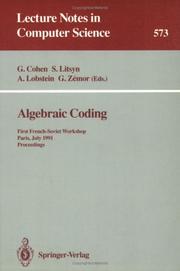
ISBN: 0387551301 3540551301 3540467394 Year: 1991 Publisher: New York, NY : Springer-Verlag,
Abstract | Keywords | Export | Availability | Bookmark
 Loading...
Loading...Choose an application
- Reference Manager
- EndNote
- RefWorks (Direct export to RefWorks)
This volume presents the proceedings of the first French-Soviet workshop on algebraic coding, held in Paris in July 1991. The idea for the workshop, born in Leningrad (now St. Petersburg) in 1990, was to bring together some of the best Soviet coding theorists. Scientists from France, Finland, Germany, Israel, Italy, Spain, and the United States also attended. The papers in the volume fall rather naturally into four categories: - Applications of exponential sums - Covering radius - Constructions -Decoding.
-681.3*E4 --- Coding and information theory: data compaction and compression; formal modelsof communication; nonsecret encoding schemes--See also {681.3*H11} --- 681.3*E4 Coding and information theory: data compaction and compression; formal modelsof communication; nonsecret encoding schemes--See also {681.3*H11} --- Coding theory --- 681.3*E4 --- Congresses --- Congresses. --- Coding theory - Congresses. --- Information theory. --- Coding theory. --- Geometry, algebraic. --- Combinatorics. --- Telecommunication. --- Theory of Computation. --- Coding and Information Theory. --- Algebraic Geometry. --- Communications Engineering, Networks. --- Electric communication --- Mass communication --- Telecom --- Telecommunication industry --- Telecommunications --- Communication --- Information theory --- Telecommuting --- Combinatorics --- Algebra --- Mathematical analysis --- Data compression (Telecommunication) --- Digital electronics --- Machine theory --- Signal theory (Telecommunication) --- Computer programming --- Communication theory --- Cybernetics --- Algebraic geometry --- Geometry
Dissertation
ISBN: 9056826492 Year: 2005 Publisher: Heverlee Katholieke Universiteit Leuven. Faculteit Ingenieurswetenschappen
Abstract | Keywords | Export | Availability | Bookmark
 Loading...
Loading...Choose an application
- Reference Manager
- EndNote
- RefWorks (Direct export to RefWorks)
In deze thesis bestuderen we de bouwblokken van cryptografische systemen die gebruikt worden in symmetrische cryptografie. De bouwblokken kunnen gezien worden als Booleaanse functies voor een één dimensionale uitgang en vector Booleaanse functies, ook S(ubstitutie)-boxen genoemd, indien de uitgang meer dan één bit is. We beginnen met een gedetailleerde veiligheidsanalyse voor de filter-en combinatiegenerator, welke de twee meest voorkomende en bestudeerde stroomcijfers zijn. Uit deze analyse leiden we de minimale veiligheidsvereisten af voor de Booleaanse functie in de generator. Vervolgens bestuderen we het bestaan van dergelijke functies die tevens een efficiënte implementatie bezitten. Symmetrische functies en Booleaanse functies die afgeleid worden van bijectieve en sterk niet-lineaire machtfuncties worden hiervoor onderzocht. Om Booleaanse functies in het algemeen te bestuderen, leiden we eerst de affiene equivalentie klassen af voor Booleaanse functies in 5 variabelen en 6 en 7 variabelen met graad kleiner dan of gelijk aan 3. Uit deze classificatie volgen verschillende resultaten: nieuwe eigenschappen voor de maximaal resiliënte Booleaanse functies van graad 3, nieuwe exacte waarden en grenzen voor de afstand van een resiliënte functie tot functies van lagere graad, en het feit dat alle maximaal niet-lineaire functies in dimensie kleiner of gelijk aan 8 en graad kleiner of gelijk aan drie tot de Maiorana-McFarland klasse behoren. We bekijken ook de sterkte van twee vaak voorkomende bouwblokken in cryptografische algoritmen, namelijk de optelling en vermenigvuldiging in het veld. In het bijzonder stellen we compacte vergelijkingen op voor de niet-lineaire combinaties van hun uitgangscomponenten. De thesis wordt afgesloten met een veralgemening van verschillende cryptografische eigenschappen van Booleaanse functies door te werken in een nieuwe metriek. Deze nieuwe eigenschappen resulteren in een beter begrip van de eigenschappen van Booleaanse functies. Hierdoor kunnen we functies construeren waarvoor de veiligheid is uitgedrukt m.b.t. specifieke monotone verzamelingen in plaats van de veiligheid m.b.t. alle monotone verzamelingen met dezelfde cardinaliteit zoals in de gewone definities. Tenslotte tonen we in dit veralgemeende kader de verbanden aan tussen resiliënte functies enerzijds en foutverbeterende codes en orthogonale rijen anderzijds. This thesis deals with building blocks of cryptosystems in symmetric cryptography. The building blocks can be seen as Boolean functions for a one dimensional output and vectorial Boolean functions, also called S(ubstitution)-boxes, for a multi dimensional output. We start with a thorough security analysis of the filter and combination generator in order to derive the minimal requirements on the Boolean function in the generator. Then, we investigate the existence of efficiently implementable functions satisfying these requirements. For this purpose, we study the symmetric functions and the Boolean functions that are affine equivalent to the trace function of highly nonlinear bijective power functions. In order to study Boolean functions with a broader perspective, we derive the affine equivalence classes of Boolean functions in 5 variables and 6 and 7 variables of degree less than or equal to 3. From this classification, we find several new properties on maximum resilient cubic Boolean functions, distance of resilient functions to low degree functions, and cubic bent functions in less than or equal to 8 variables. We also study the strength of two building blocks which are frequently used in cryptographic algorithms, namely the addition and multiplication in a finite field. In particular, we derive a compact representation of the algebraic equations representing the nonlinear combinations of the output components of the S-boxes. Finally, by considering a new metric, we generalize several cryptographic properties of Boolean functions. The new definitions result in a better understanding of these properties and provide a better insight in the space defined by this metric. This approach leads to the construction of ''hand-made'' Boolean functions, i.e., functions for which the security with respect to some specific monotone sets of inputs is considered, instead of the security with respect to all possible monotone sets with the same cardinality, as in the usual definitions. We show relations between resilient Boolean functions, error-correcting codes, and orthogonal arrays in this generalized setting.
Academic collection --- 681.3*D46 <043> --- 681.3*E4 <043> --- 681.3*E4 <043> Coding and information theory: data compaction and compression formal modelsof communication nonsecret encoding schemes--See also {681.3*H11}--Dissertaties --- Coding and information theory: data compaction and compression formal modelsof communication nonsecret encoding schemes--See also {681.3*H11}--Dissertaties --- 681.3*D46 <043> Security and protection: access controls authentication cryptographic controls information flow controls security kernels verification (Operating systems)--Dissertaties --- Security and protection: access controls authentication cryptographic controls information flow controls security kernels verification (Operating systems)--Dissertaties --- Theses --- 681.3*E3 <043> --- Data encryption: data encryption standard; DES; public key cryptosystems--Dissertaties --- 681.3*E4 <043> Coding and information theory: data compaction and compression; formal modelsof communication; nonsecret encoding schemes--See also {681.3*H11}--Dissertaties --- Coding and information theory: data compaction and compression; formal modelsof communication; nonsecret encoding schemes--See also {681.3*H11}--Dissertaties --- 681.3*D46 <043> Security and protection: access controls; authentication; cryptographic controls; information flow controls; security kernels; verification (Operating systems)--Dissertaties --- Security and protection: access controls; authentication; cryptographic controls; information flow controls; security kernels; verification (Operating systems)--Dissertaties
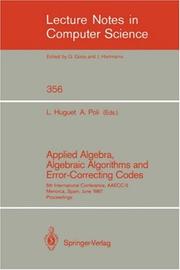
ISBN: 3540510826 0387510826 3540461507 Year: 1989 Volume: vol 356 Publisher: Berlin Springer
Abstract | Keywords | Export | Availability | Bookmark
 Loading...
Loading...Choose an application
- Reference Manager
- EndNote
- RefWorks (Direct export to RefWorks)
The present volume contains the proceedings of the AAECC-5 Conference held at Menorca (Balearic Islands), June 15-19, 1987. The annual International AAECC Conference covers a range of topics related to Applied Algebra, Error-Correcting Codes, Finite Algebraic Structures, Computational Methods and Complexity in Algebra and Geometry. For the AAECC-5 Conference 73 papers were presented. Out of these thirty papers were selected for publication in the proceedings. They deal with topics such as error correcting codes (concerning problems of covering radius, decoding methods, expert systems and general results in coding theory), computational algebra, Gröbner basis, complexity, finite algebra and graphs. The proceedings of the 6th conference are published as Vol. 357 of the Lecture Notes in Computer Science.
Information systems --- 681.3*E4 --- 681.3*G2 --- 681.3*I1 --- Coding and information theory: data compaction and compression; formal modelsof communication; nonsecret encoding schemes--See also {681.3*H11} --- Discrete mathematics (Mathematics of computing) --- Algebraic manipulation (Computing methodologies) --- Error-correcting codes (Information theory) --- Algebra --- Computer algorithms --- Congresses. --- Data processing --- 681.3*I1 Algebraic manipulation (Computing methodologies) --- 681.3*G2 Discrete mathematics (Mathematics of computing) --- 681.3*E4 Coding and information theory: data compaction and compression; formal modelsof communication; nonsecret encoding schemes--See also {681.3*H11} --- Codes, Error-correcting (Information theory) --- Error-detecting codes (Information theory) --- Forbidden-combination check (Information theory) --- Self-checking codes (Information theory) --- Artificial intelligence --- Automatic control --- Coding theory --- Information theory --- Mathematics --- Mathematical analysis --- Data processing&delete& --- Congresses --- Data structures (Computer scienc. --- Coding theory. --- Data Structures and Information Theory. --- Coding and Information Theory. --- Symbolic and Algebraic Manipulation. --- Data processing. --- Data compression (Telecommunication) --- Digital electronics --- Machine theory --- Signal theory (Telecommunication) --- Computer programming
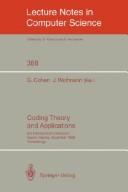
ISBN: 0387516433 3540516433 3540467262 Year: 1989 Volume: 388 Publisher: Berlin Springer
Abstract | Keywords | Export | Availability | Bookmark
 Loading...
Loading...Choose an application
- Reference Manager
- EndNote
- RefWorks (Direct export to RefWorks)
Coding theory --- Codage --- Congresses --- Congrès --- Congrès --- Data encryption: data encryption standard; DES; public key cryptosystems --- Coding and information theory: data compaction and compression; formal modelsof communication; nonsecret encoding schemes--See also {681.3*H11} --- 681.3*E4 Coding and information theory: data compaction and compression; formal modelsof communication; nonsecret encoding schemes--See also {681.3*H11} --- 681.3*E3 Data encryption: data encryption standard; DES; public key cryptosystems --- Information systems --- 681.3*E3 --- 681.3*E4 --- Coding theory. --- Data encryption (Computer science). --- Combinatorics. --- Coding and Information Theory. --- Discrete Mathematics. --- Cryptology. --- Combinatorics --- Algebra --- Mathematical analysis --- Data encoding (Computer science) --- Encryption of data (Computer science) --- Computer security --- Cryptography --- Data compression (Telecommunication) --- Digital electronics --- Information theory --- Machine theory --- Signal theory (Telecommunication) --- Computer programming
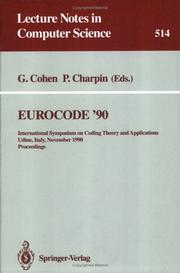
ISBN: 3540543031 354047546X Year: 1991 Volume: vol 514 Publisher: Berlin Heidelberg Budapest Springer Verlag
Abstract | Keywords | Export | Availability | Bookmark
 Loading...
Loading...Choose an application
- Reference Manager
- EndNote
- RefWorks (Direct export to RefWorks)
This book presents a selection of the papers presented at EUROCODE '90, the symposium on coding theory held in Udine, Italy, November 1990. It gives the state of the art on coding in Europe and ranges from theoretical top- ics like algebraic geometry and combinatorial coding to applications like modulation, real-space decoding and VLSI implementation. The book is divided into eight sections: - Algebraic codes - Combinatorial codes - Geometric codes - Protection of information - Convolutional codes - Information theory - Modulation - Applications of coding. Five of the sections are introduced by an invited contribution.
Coding theory --- -681.3*E3 --- 681.3*E4 --- Data compression (Telecommunication) --- Digital electronics --- Information theory --- Machine theory --- Signal theory (Telecommunication) --- Computer programming --- Congresses --- Data encryption: data encryption standard; DES; public key cryptosystems --- Coding and information theory: data compaction and compression; formal modelsof communication; nonsecret encoding schemes--See also {681.3*H11} --- 681.3*E4 Coding and information theory: data compaction and compression; formal modelsof communication; nonsecret encoding schemes--See also {681.3*H11} --- 681.3*E3 Data encryption: data encryption standard; DES; public key cryptosystems --- 681.3*E3 --- Information theory. --- Data encryption (Computer science). --- Coding theory. --- Theory of Computation. --- Discrete Mathematics. --- Cryptology. --- Coding and Information Theory. --- Data encoding (Computer science) --- Encryption of data (Computer science) --- Computer security --- Cryptography --- Communication theory --- Communication --- Cybernetics
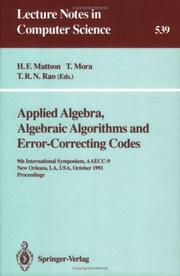
ISBN: 3540545220 0387545220 3540384367 Year: 1991 Volume: vol 539 Publisher: Berlin ; New York, NY : Springer-Verlag,
Abstract | Keywords | Export | Availability | Bookmark
 Loading...
Loading...Choose an application
- Reference Manager
- EndNote
- RefWorks (Direct export to RefWorks)
The AAECC conferences focus on the algebraic aspects of modern computer science, which includes the most up-to-date and advanced topics. The topic of error-correcting codes is one where theory and implementation are unifiedinto a subject both of mathematical beauty and of practical importance. Algebraic algorithms are not only interesting theoretically but also important in computer and communication engineering and many other fields. This volume contains the proceedings of the 9th AAECC conference, held in New Orleans, LA, in October 1991. Researchers from Europe, America, Japan and other regions of the world presented papers at the conference. The papers present new results of recent theoretical and application-oriented research in the field.
Algebra --- -Algorithms --- -Error-correcting codes (Information theory) --- -681.3*E4 --- Codes, Error-correcting (Information theory) --- Error-detecting codes (Information theory) --- Forbidden-combination check (Information theory) --- Self-checking codes (Information theory) --- Artificial intelligence --- Automatic control --- Coding theory --- Information theory --- Algorism --- Arithmetic --- Mathematics --- Mathematical analysis --- Data processing --- -Congresses --- Congresses --- Coding and information theory: data compaction and compression; formal modelsof communication; nonsecret encoding schemes--See also {681.3*H11} --- Foundations --- Algorithms --- Error-correcting codes (Information theory) --- Congresses. --- 681.3*E4 Coding and information theory: data compaction and compression; formal modelsof communication; nonsecret encoding schemes--See also {681.3*H11} --- 681.3*E4 --- Data processing&delete& --- Error-correcting codes (Information theory) - Congresses. --- Algebra - Data processing - Congresses. --- Algorithms - Congresses. --- Algebra. --- Information theory. --- Coding theory. --- Combinatorics. --- Discrete Mathematics. --- Theory of Computation. --- Coding and Information Theory. --- Symbolic and Algebraic Manipulation. --- Data processing. --- Combinatorics --- Data compression (Telecommunication) --- Digital electronics --- Machine theory --- Signal theory (Telecommunication) --- Computer programming --- Communication theory --- Communication --- Cybernetics
| Listing 1 - 10 of 21 | << page >> |
Sort by
|

 Search
Search Feedback
Feedback About UniCat
About UniCat  Help
Help News
News